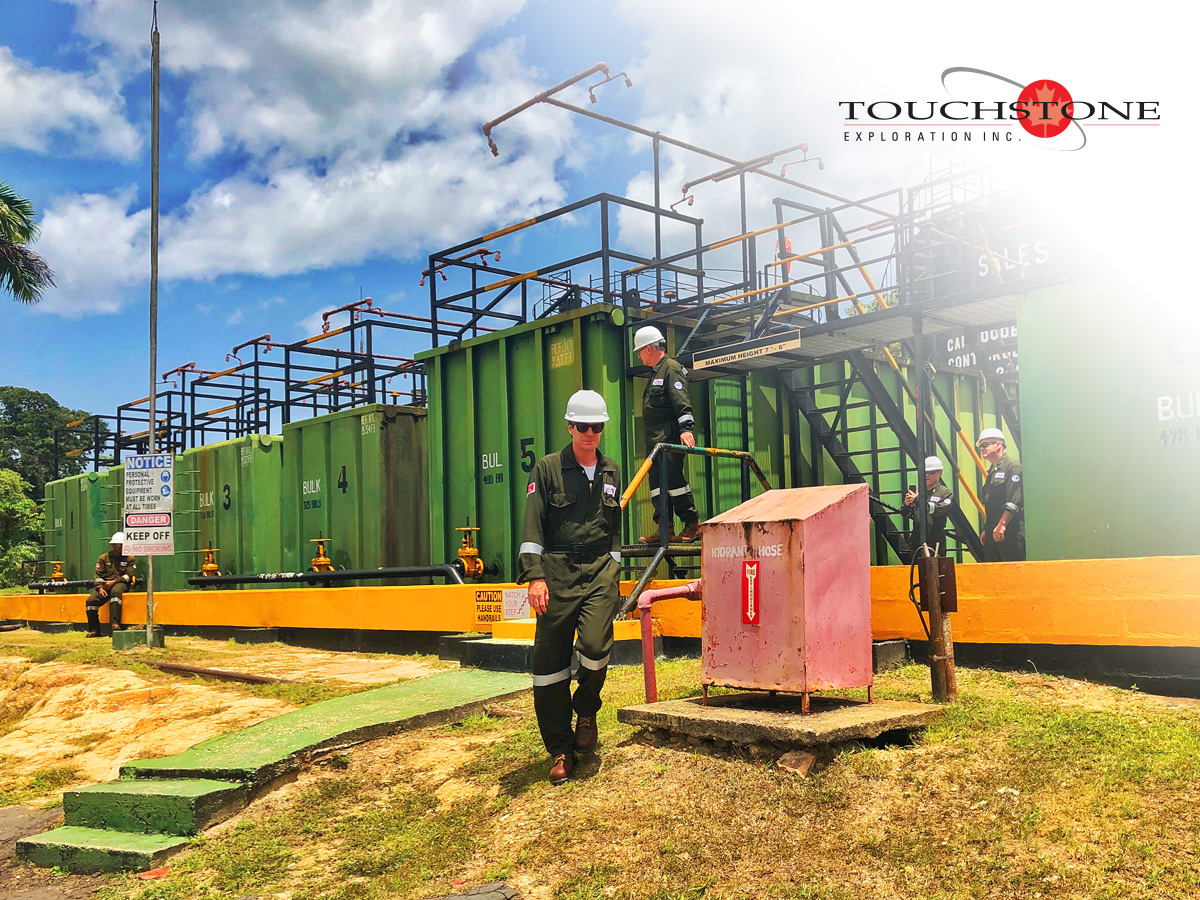Touchstone Exploration Inc (LON:TXP) has announced highlights of its independent reserves evaluation of the Cascadura Assessment Area prepared by GLJ Ltd. with an effective date of June 30, 2020. Highlights of our total proved, total proved plus probable and total proved plus probable plus possible reserves from the Cascadura Reserves Report are provided below. Unless otherwise stated, all financial amounts herein are rounded to thousands of United States dollars.
The Cascadura Assessment Area is located in the Company’s Ortoire exploration block, onshore in the Republic of Trinidad and Tobago (Touchstone 80% working interest operator, Heritage Petroleum Company Limited 20% working interest). The Cascadura Assessment Area represents the geologically and geophysically defined reservoirs which were evaluated by the Company’s Cascadura-1ST1 exploration well drilled in the fourth quarter of 2019 and tested in the first half of 2020.
The Cascadura Reserves Report evaluates the Cascadura Assessment Area on a stand-alone basis and provides a reserves estimate of natural gas and natural gas liquids, as well as a before income tax estimate of net present values of future net revenues as of June 30. 2020. The Cascadura Reserves Report should be considered as supplementary to, and reconciled with, the volumes and future net revenues disclosed in the Company’s 2019 Annual Information Form dated March 25, 2020 which has been filed on SEDAR and can be accessed at www.sedar.com.
Paul R. Baay, President and Chief Executive Officer, commented:
“We are delighted to report that the independent reserves report verifies the material size of the reserves yet to be produced in the Cascadura structure and provides the groundwork for a multi-year future onshore development program in Trinidad. Through the excellent work of the Touchstone team in the drilling of our first two exploration wells, we have successfully proven up the hydrocarbon bearing turbidite model in Ortoire. This model will be further evaluated by our next two exploration targets at Chinook and Cascadura deep, with drilling at Chinook on track to commence within the next few weeks.
We could not have envisioned a better start from the first two wells of the Ortoire exploration program, and we look forward to updating the market and our Trinidad stakeholders as we progress with our Ortoire exploration and development activities in the coming months.”
Cascadura Reserves Report Highlights
· Gross Discovered Petroleum Initially-in-Place is estimated to be between 571.5 Bcf of natural gas in the High Estimate and 241.2 Bcf in the Low Estimate, with a Best Estimate of 398.5 Bcf.
· Company working interest 3P reserves of 73,190 Mboe (85% recovery of High Estimate DPIIP), 2P reserves of 45,030 Mboe (75% recovery of Best Estimate DPIIP), and 1P reserves of 23,622 Mboe (65% recovery of the Low Estimate DPIIP).
· Net peak production is estimated to be 22,600 boe/d in the 3P forecast, 15,108 boe/d in the 2P forecast, and 10,266 boe/d in the 1P forecast.
· Estimated before tax 3P 10% discounted net present value of future net revenues (“NPV10”) of $802.9 million, 2P NPV10 of $519.2 million, and 1P NPV10 of $287.7 million.
· Net future development costs associated with the development of the Cascadura Assessment Area is estimated at $11.6 million for 1P reserves and $15.8 million for both 2P and 3P reserves.
James Shipka, Touchstone Exploration Chief Operating Officer, commented:
“GLJ’s independent evaluation of the Cascadura-1ST1 production test results and the subsequent reserves evaluation of the Cascadura Assessment Area confirms the tremendous potential of the Ortoire exploration block. The Cascadura Reserves Report combines both the pressure and flow testing of the Cascadura-1ST1 well with the 3D seismic data which covers the entirety of the Cascadura structure as we now understand it. The team is currently working hard to design the facilities and infrastructure required to bring the Cascadura gas and liquids to market as quickly as possible, and with GLJ estimating there is in excess of 500 Bcf of discovered natural gas in place in the Cascadura area, it is evident that we have a clear pathway to a multi-year development program.”
Cascadura Reserves Report Summary
Touchstone’s petroleum reserves for the Cascadura Assessment Block were evaluated by independent qualified reserves evaluator, GLJ, in accordance with definitions, standards and procedures contained in the Canadian Oil and Gas Evaluation (“COGE”) Handbook and National Instrument 51-101 – Standards of Disclosure for Oil and Gas Activities (“NI 51-101”). The reserve estimates set forth below are based upon GLJ’s Cascadura Reserves Report dated July 17, 2020 with an effective date of June 30, 2020. All values in this announcement are based on GLJ’s July 1, 2020 forecast prices and estimates of future operating and capital development costs as at June 30, 2020. In certain tables set forth below, the columns may not add due to rounding.
Summary of Cascadura Assessment Area Company Gross Reserves as of June 30, 2020 by Product Type(1),(2)
| Reserves Category | Conventional Natural Gas (MMcf) | Natural Gas Liquids (Mbbl) | Total Oil Equivalent(Mboe) |
| Proved | |||
| Developed Producing | – | – | – |
| Developed Non-Producing | 41,602 | 1,061 | 7,995 |
| Undeveloped | 81,313 | 2,074 | 15,627 |
| Total Proved | 122,916 | 3,136 | 23,622 |
| Probable | 111,402 | 2,841 | 21,408 |
| Total Proved plus Probable | 234,318 | 5,977 | 45,030 |
| Possible | 146,530 | 3,738 | 28,160 |
| Total Proved plus Probable plus Possible | 380,848 | 9,715 | 73,190 |
Notes:
(1) Gross Reserves are the Company’s working interest share of the remaining reserves before deduction of any royalties.
(2) See “Advisories: Reserve Advisory, Oil and Gas Measures and Definitions of Petroleum Reserves“.
Summary of Cascadura Assessment Area Company Net Present Values of Future Net Revenues as of June 30, 2020(1),(2),(3)
| Reserves Category | Net Present Values of Future Net Revenues Before Income Taxes Discounted at (% per year) ($000’s) | ||||
| 0% | 5% | 10% | 15% | 20% | |
| Proved | |||||
| Developed Producing | – | – | – | – | – |
| Developed Non-Producing | 161,557 | 128,781 | 105,583 | 88,572 | 75,714 |
| Undeveloped | 330,677 | 241,377 | 182,167 | 141,328 | 112,193 |
| Total Proved | 492,234 | 370,158 | 287,749 | 229,901 | 187,908 |
| Probable | 477,556 | 324,397 | 231,458 | 171,836 | 131,760 |
| Total Proved plus Probable | 969,790 | 694,555 | 519,207 | 401,737 | 319,668 |
| Possible | 653,133 | 416,464 | 283,674 | 203,110 | 151,106 |
| Total Proved plus Probable plus Possible | 1,622,923 | 1,111,019 | 802,881 | 604,847 | 470,774 |
Notes:
(1) Based on GLJ’s July 1, 2020 escalated price forecast. See “Summary of Pricing and Inflation Assumptions“.
(2) See “Advisories: Reserve Advisory and Definitions of Petroleum Reserves“.
(3) GLJ did not forecast after tax net present values of future net revenues in the Cascadura Reserves Report given the Cascadura Assessment Area is an asset owned by a Trinidad corporate entity. Calculating income taxes on cash flows derived from a stand-alone asset would not be indicative of business entity level income taxes.
Summary of Pricing and Inflation Assumptions
The following table sets forth GLJ’s forecasted benchmark reference pricing and inflation rates reflected in the Cascadura Reserves Report effective June 30, 2020.
| Forecast Year | Brent Spot Crude Oil ($/bbl)(1) | Conway Condensate ($/bbl)(1) | Henry HubNatural Gas($/MMBtu)(1) | Inflation Rates (%/year)(2) |
| 2020 Q3-Q4 | 43.50 | 36.90 | 2.08 | 0.0 |
| 2021 | 48.00 | 39.60 | 2.55 | 0.0 |
| 2022 | 51.50 | 42.75 | 2.65 | 1.0 |
| 2023 | 56.50 | 47.25 | 2.75 | 2.0 |
| 2024 | 60.00 | 50.40 | 2.85 | 2.0 |
| 2025 | 62.95 | 53.06 | 2.95 | 2.0 |
| 2026 | 64.13 | 54.12 | 3.01 | 2.0 |
| 2027 | 65.33 | 55.20 | 3.07 | 2.0 |
| 2028 | 66.56 | 56.30 | 3.13 | 2.0 |
| 2029 | 67.81 | 57.43 | 3.19 | 2.0 |
| Thereafter | +2.0% / year | +2.0% / year | +2.0% / year | 2.0 |
Notes:
(1) This summary table identifies benchmark reference pricing schedules that might apply to a reporting issuer. Product sales prices will reflect these reference prices with further adjustments for quality differentials and transportation to point of sale. See “Advisories: Reserve Advisory”.
(2) Inflation rates for forecasting pricing and costs.
Cascadura Assessment Area Company Future Development Costs(1)
The following table provides information regarding the development costs deducted in the estimation of the Company’s working interest future net revenue using forecast prices and costs included in the Cascadura Reserves Report.
| Year | Proved Reserves ($000’s) | Proved plus Probable Reserves ($000’s) | Proved plus Probable plus Possible Reserves ($000’s) |
| 2020 | – | – | – |
| 2021 | 1,000 | 1,000 | 1,000 |
| 2022 | 6,464 | 6,464 | 6,464 |
| 2023 | 4,121 | 4,121 | 4,121 |
| 2024 | – | 4,203 | 4,203 |
| Total undiscounted | 11,585 | 15,788 | 15,788 |
| Total discounted at 10% per year | 9,347 | 12,218 | 12,218 |
Note:
(1) See “Advisories: Reserve Advisory“.
Reserve Advisory
The reserves estimates prepared herein have been evaluated by an independent qualified reserves evaluator in accordance with NI 51-101 and the COGE Handbook. The disclosure in this announcement summarizes certain information contained in the Cascadura Reserves Report but represents only a portion of the disclosure required under NI 51-101. In accordance with Canadian practice, production volumes and revenues are reported on a Company gross basis, before deduction of crown and other royalties. Unless otherwise specified, all reserves volumes in this announcement (and all information derived therefrom) are based on Company gross reserves using forecast prices and costs.
The recovery and reserve estimates provided herein are estimates only, and there is no guarantee that the estimated reserves will be recovered. Actual reserves may eventually prove to be greater than or less than the estimates provided herein. This announcement (i) summarizes the reserves of the Company’s Cascadura Assessment Area only and the net present values of future net revenue for such reserves using forecast prices and costs as at June 30, 2020 prior to provision for income taxes, interest, general and administrative expenses, the impact of any financial derivatives or liabilities associated with the abandonment and reclamation of certain facilities and wells, and (ii) should be considered as supplementary to, and reconciled with, the volumes and net present values of future net revenues disclosed in the Company’s 2019 Annual Information Form dated March 25, 2020 which has been filed on SEDAR and can be accessed at www.sedar.com. The estimates of reserves and future net revenue have been made assuming that the development will occur. The estimates of reserves and future net revenue for individual properties may not reflect the same confidence level as estimates of reserves and future net revenue for all properties, due to the effects of aggregation. It should not be assumed that the present worth of estimated before tax future net revenues presented in the table above represent the fair market value of the reserves. There is no assurance that the forecast prices and costs assumptions will be attained, and variances could be material. The term “future development costs” does not have a standardized meaning and should not be used to make comparisons.
The DPIIP set forth in this announcement has been provided for the sole purpose of highlighting the recovery factors used by GLJ in attributing reserves to the Cascadura Assessment Area effective as of June 30, 2020. As disclosed below, DPIIP is defined by COGE as that quantity of petroleum that is estimated, as of a given date, to be contained in known accumulations prior to production. The recoverable portion of DPIIP includes production, reserves and contingent resources; the remainder is unrecoverable. It should not be assumed that any portion of the DPIIP set forth in this announcement is recoverable other than the portion which has been attributed reserves by GLJ. There is uncertainty that it will be commercially viable to produce any portion of the DPIIP other than the portion that is attributed reserves.
In the Cascadura Reserves Report, GLJ estimated conventional natural gas revenues referencing Henry Hub natural gas forecasted pricing and natural gas liquids revenues based on forecasted Conway Condensate reference pricing. The Company is currently negotiating a marketing agreement for all petroleum products produced on the Ortoire property, and accordingly, such revenue estimates in the Cascadura Reserves Report may not be attained, and variances could be material. In addition, GLJ forecasted reserve volumes and future cash flows based upon volumetric interpretations and extrapolations based upon well testing. Notwithstanding contractual options for the extension of the Company’s Ortoire block production and exploration agreement (the “Licence”) upon a commercial discovery, the forecasted economic limit of individual wells and the net present values of future net revenue therefrom is currently beyond the initial exploration term of the Licence.
Definitions of Petroleum Reserves
The reserves have been categorized accordance with the reserves definitions as set out in the COGE Handbook, which are set out below.
“Reserves” are estimated remaining quantities of petroleum anticipated to be recoverable from known accumulations, as of a given date, based on the analysis of drilling, geological, geophysical, and engineering data; the use of established technology; and specified economic conditions, which are generally accepted as being reasonable. Reserves are further classified according to the level of certainty associated with the estimates as follows:
“Proved Developed Producing Reserves” are those reserves that are expected to be recovered from completion intervals open at the time of the estimate. These reserves may be currently producing, or if shut-in, they must have previously been on production, and the date of resumption of production must be known with reasonable certainty.
“Proved Developed Non-Producing Reserves” are those reserves that either have not been on production or have previously been on production but are shut-in, and the date of resumption of production is unknown.
“Proved Undeveloped Reserves” are those reserves expected to be recovered from known accumulations where a significant expenditure (e.g. when compared to the cost of drilling a well) is required to render them capable of production. They must fully meet the requirements of the reserves category (proved, probable, possible) to which they are assigned.
“Proved Reserves” are those reserves that can be estimated with a high degree of certainty to be recoverable. It is likely that the actual remaining quantities recovered will exceed the estimated proved reserves.
“Probable Reserves” are those additional reserves that are less certain to be recovered than proved reserves. It is equally likely that the actual remaining quantities recovered will be greater or less than the sum of the estimated proved plus probable reserves.
“Possible Reserves” are those additional reserves that are less certain to be recovered than probable reserves. There is a 10 percent probability that the quantities actually recovered will equal or exceed the sum of proved plus probable plus possible reserves. It is unlikely that the actual remaining quantities recovered will exceed the sum of the estimated proved plus probable plus possible reserves.
“Discovered Petroleum Initially-in-Place (“DPIIP)” is that quantity of petroleum that is estimated, as of a given date, to be contained in known accumulations prior to production. The recoverable portion of DPIIP includes production, reserves, and contingent resources; the remainder is categorized as unrecoverable.
“Uncertainty Ranges” are described in the COGE Handbook as low, best, and high estimates for reserves and resources as follows:
The “Low Estimate” is considered to be a conservative estimate of the quantity that will actually be recovered. It is likely that the actual remaining quantities recovered will exceed the low estimate. If probabilistic methods are used, there should be at least a 90 percent probability (P90) that the quantities actually recovered will equal or exceed the low estimate.
The “Best Estimate” is considered to be the best estimate of the quantity that will actually be recovered. It is equally likely that the actual remaining quantities recovered will be greater or less than the best estimate. If probabilistic methods are used, there should be at least a 50 percent probability (P50) that the quantities actually recovered will equal or exceed the best estimate.
The “High Estimate” is considered to be an optimistic estimate of the quantity that will actually be recovered. It is unlikely that the actual remaining quantities recovered will exceed the high estimate. If probabilistic methods are used, there should be at least a 10 percent probability (P10) that the quantities actually recovered will equal or exceed the high estimate.
Oil and Gas Measures
Where applicable, natural gas has been converted to barrels of oil equivalent based on six thousand cubic feet to one barrel of oil. The barrel of oil equivalent rate is based on an energy equivalent conversion method primarily applicable at the burner tip, and given that the value ratio based on the current price of crude oil as compared to natural gas is significantly different than the energy equivalency of the 6:1 conversion ratio, utilizing the 6:1 conversion ratio may be misleading as an indication of value. The boe rate is based on an energy equivalency conversion method primarily applicable at the burner tip and does not represent a value equivalent at the wellhead. Use of boe in isolation may be misleading.







































